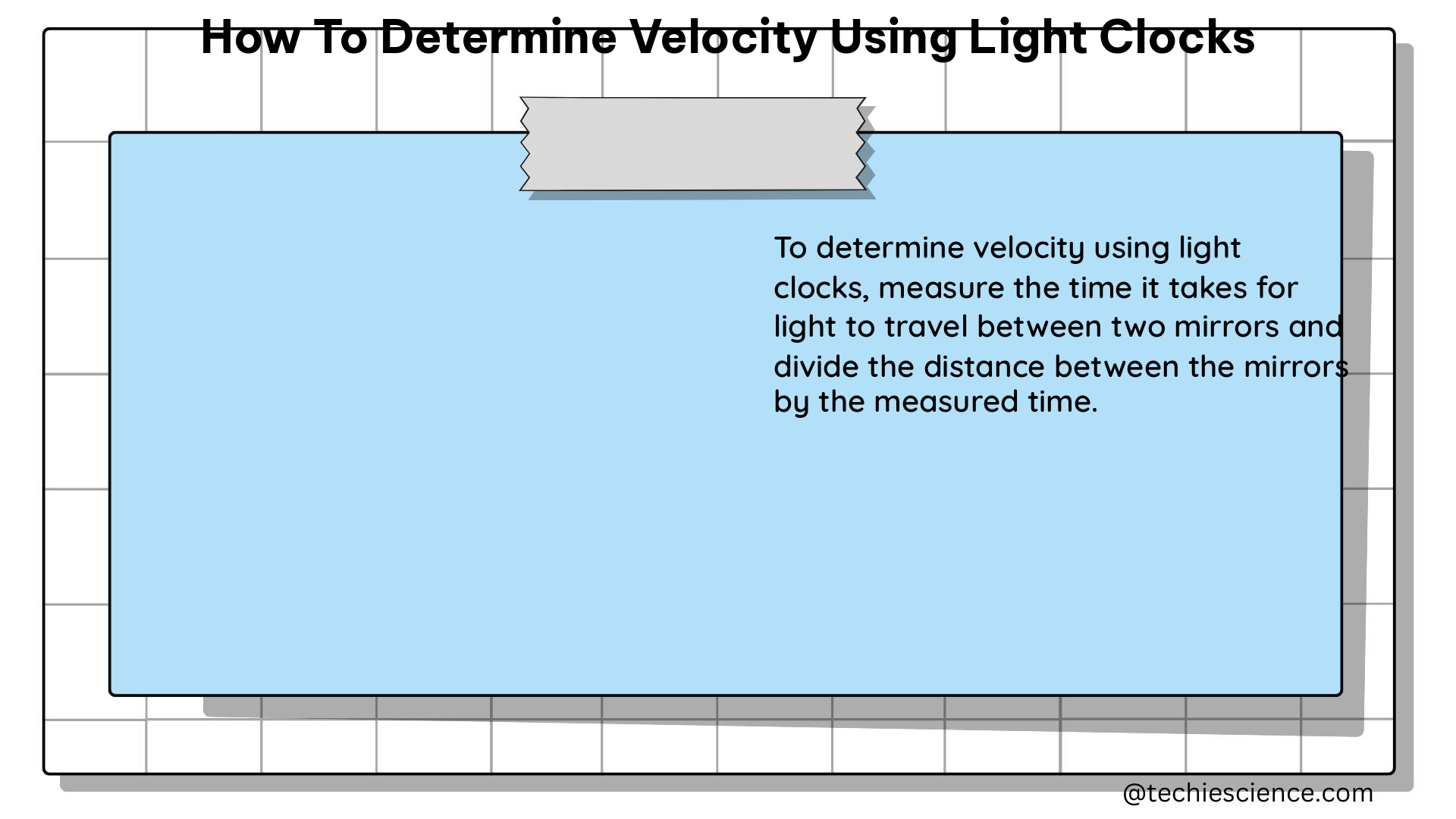Determining velocity using light clocks is a fundamental concept in physics that relies on the constant speed of light and the principles of time dilation. This comprehensive guide will provide you with a detailed understanding of the techniques, formulas, and practical applications of this method.
Understanding the Time-of-Flight Method
The time-of-flight method is the primary technique used to determine velocity using light clocks. This method involves measuring the time it takes for light to travel a known distance and then calculating the speed of light using the formula:
Physics Formula: c = d/t, where c is the speed of light, d is the distance traveled by light, and t is the time taken for light to cover that distance.
To demonstrate this method, a setup can be created using a football field, a mirror, and a laser. By pointing the laser at the mirror from the 50-yard line and measuring the time it takes for the light to bounce back and hit a sensor, the speed of light can be determined.
Accounting for Time Dilation

When the observer is in motion, either towards or away from the mirror, time dilation occurs, affecting the sensor’s measurement. However, the speed of light remains constant. This is because:
Theorem: The speed of light (c) is constant and does not change regardless of the observer’s velocity.
When moving towards the mirror, the sensor’s slower measurement compensates for the movement, keeping the speed of light consistent. Conversely, when moving away from the mirror, both the observer and the sensor experience time dilation, again compensating for the movement and maintaining the speed of light.
Historical Measurements of the Speed of Light
The time-of-flight method has been used throughout history to measure the speed of light. One of the earliest and most notable examples is Rømer’s determination of the speed of light in 1676.
Physics Example: Rømer’s determination of the speed of light in 1676 involved observing the eclipses of Jupiter’s moons. He noticed a difference in the predicted and observed times of these eclipses, which he attributed to the varying distance between Earth and Jupiter. By calculating the difference in these times, he obtained a value for the speed of light.
Physics Numerical Problem: Given the distance between Earth and Jupiter as 628.7 million kilometers and the difference in predicted and observed times of eclipses as 1000 seconds, we can calculate the speed of light using the formula c = d/t. Plugging in the values, we get:
c = 628.7 × 10^6 m / 1000 s
c = 628,700 km/s
Rømer’s measurement of the speed of light was 214,000 kilometers per second, which is lower than the modern value due to inaccuracies in the astronomical unit used in his calculations.
Measurements: The modern value for the speed of light is 299,792,458 meters per second, set in 1983.
Practical Applications and Experimental Setup
The time-of-flight method can be used in various practical applications, such as:
- Measuring the speed of light in different media (e.g., air, water, glass)
- Determining the refractive index of materials
- Calibrating and testing optical devices and systems
To set up a light clock experiment, you will need the following equipment:
- Laser
- Mirror
- Sensor (e.g., photodetector)
- Measuring device (e.g., oscilloscope, timer)
- Ruler or measuring tape
The setup would involve placing the laser and mirror at a known distance apart, with the sensor positioned to detect the reflected light. By measuring the time it takes for the light to travel from the laser to the mirror and back to the sensor, you can calculate the speed of light using the formula c = d/t.
Figure: A diagram showing the setup of a light clock experiment with a laser, mirror, and sensor.
Additional Data Points and Facts
- Rømer’s measurement of the speed of light was 214,000 kilometers per second, which is lower than the modern value due to inaccuracies in the astronomical unit used in his calculations.
- The modern value for the speed of light is 299,792,458 meters per second, set in 1983.
- The time-of-flight method has been used to measure the speed of light in various media, such as air, water, and glass, to determine their refractive indices.
- Optical devices and systems, such as fiber-optic communication networks, rely on accurate measurements of the speed of light for proper calibration and operation.
- The constancy of the speed of light is a fundamental principle in Einstein’s theory of special relativity, which has been extensively tested and verified through numerous experiments.
Conclusion
Determining velocity using light clocks is a powerful technique that relies on the constant speed of light and the principles of time dilation. By understanding the time-of-flight method, accounting for time dilation effects, and exploring historical and modern measurements, you can gain a comprehensive understanding of this fundamental concept in physics. This guide has provided you with the necessary details, formulas, and practical applications to help you master the art of determining velocity using light clocks.
References
- Rømer’s Determination of the Speed of Light
- Measuring the Speed of Light at Different Velocities
- Measuring the Speed of Light Using a Laser and Mirror

The lambdageeks.com Core SME Team is a group of experienced subject matter experts from diverse scientific and technical fields including Physics, Chemistry, Technology,Electronics & Electrical Engineering, Automotive, Mechanical Engineering. Our team collaborates to create high-quality, well-researched articles on a wide range of science and technology topics for the lambdageeks.com website.
All Our Senior SME are having more than 7 Years of experience in the respective fields . They are either Working Industry Professionals or assocaited With different Universities. Refer Our Authors Page to get to know About our Core SMEs.